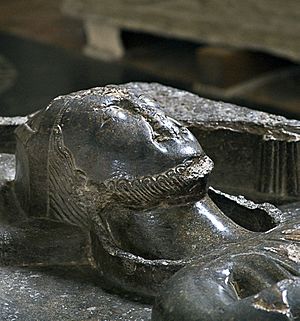Peter des Roches facts for kids
Quick facts for kids Peter des Roches |
|
|---|---|
| Bishop of Winchester | |

Head of the effigy on Roches' tomb in Winchester Cathedral
|
|
| Appointed | 1205 |
| Reign ended | 9 June 1238 |
| Predecessor | Richard Poore |
| Successor | Ralph Neville |
| Other posts | Precentor of Lincoln Archdeacon of Poitiers |
| Orders | |
| Consecration | 24 March 1206 by Pope Innocent III |
| Personal details | |
| Died | 9 June 1238 |
| Denomination | Catholic |
Peter des Roches (died June 9, 1238) was an important bishop in England. He served during the reigns of King John and his son, King Henry III. Peter was not from England; he was from a region in France called Touraine. His name, Petrus de Rupibus, means "Peter from the rocks" in Latin.
Contents
A Powerful Church Leader
Peter became a powerful advisor to King Richard I towards the end of his rule. He held important church jobs. These included being an Archdeacon in Poitiers, France. He was also a precentor (a church official who leads singing) in the diocese of Lincoln in England by 1204.
In 1205, King John helped Peter get elected as the bishop of Winchester. There was some disagreement about his election. However, Pope Innocent III confirmed it later that year. Peter became a bishop on March 24, 1206.
Supporting the King
Peter stayed loyal to King John during a difficult time. The Pope had placed an interdict on England. This meant many church services were stopped. The Pope did this because King John refused to accept Stephen Langton as the Archbishop of Canterbury. Peter supported the king through this whole period.
In 1213, Peter became the Chief Justiciar of England. This was a very important role. It meant he was the king's main legal officer. He got this job because he was so loyal to King John. He helped the king during the First Barons' War. However, by 1215, Hubert de Burgh took over this role. In 1216, Peter was also named High Sheriff of Hampshire.
Peter showed bravery at the Battle of Lincoln in 1217. He led a part of the royal army. But he had a smaller role in the government while William Marshal was in charge. After Marshal died in 1219, Peter led a group of nobles who disagreed with Hubert de Burgh.
Founding Monasteries
Peter helped start several monasteries (places where monks live) in England and France. These included Titchfield Abbey and Netley Abbey in England. He also founded La Clarté-Dieu in France. He also protected the first group of Dominican friars (a type of religious order) who came to England in 1221.
In 1225, there was a report of a plan. It was said that someone wanted to send Eleanor of Brittany to France. Eleanor was a cousin of King Henry III. She was kept at Bristol Castle because she could be a threat to the king. This plot might have been made up to make Peter look bad. He eventually lost the king's favor in 1234.
A Crusading Bishop
Peter went on the Sixth Crusade. This was a religious war to take back the Holy Land. He traveled with William Briwere, who was the Bishop of Exeter. They led an army of crusaders. They left Italy in August 1227.
Both bishops gave important advice to Frederick II. He was the Holy Roman Emperor. This was unusual because Pope Gregory IX had told everyone not to work with Frederick. The Pope had removed Frederick from the church. But Peter and William ignored the Pope's orders. They worked closely with Frederick. The money they brought was very helpful to the crusaders.
Both bishops were present when a peace agreement was signed. This was the Treaty of Jaffa in 1229. This treaty gave Jerusalem back to the Christians. After the crusade, Peter spent some time in Italy.
Peter des Roches died on June 9, 1238.
Legends and Stories
A story from the Lanercost Chronicle tells a fun tale about Peter. One day, while hunting, Peter supposedly met King Arthur. They had dinner together. Peter asked Arthur for a special gift to remember their meeting. Arthur told him to close his hand, then open it. When Peter opened his hand, a butterfly flew out! The story says that Peter could do this miracle for the rest of his life. Because of this, he became known as the "Butterfly Bishop."

